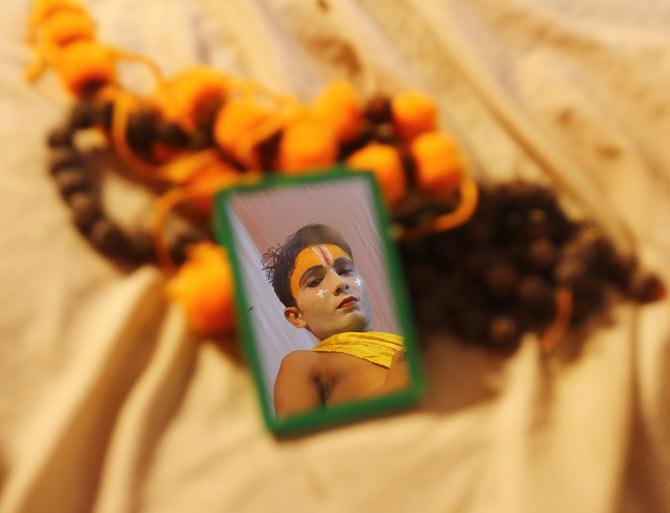
Mumbai's oldest Ram Leela plays out for 20 days at the historic Azad Maidan.
Text: Savera R Someshwar. Photographs: Hitesh Harisinghani
The rain-soaked ground, its muddy innards hidden under a grimy red carpet, stares at us passively.
Squelch in, if you must, it seems to say; I won't help, but I won't hinder either.
As we wade in through the mucky water, we are greeted by over a thousand empty plastic chairs. Puddled in the middle of each white seat is a tiny little pool of rain-water.
Ahead, ignoring these little vagaries of nature, stands the proud stage which plays host to Mumbai's oldest Ram Leela, organised by the Shree Maharashtra Ram Leela Mandal.
...

"Bacche hai, abhi tak safa badhna nahi aata (They are children, they have still not learnt to tie the turban)," says the actor, who only identifies himself as Nagaji.
Part of the Ayodhya-based Avadh Adarsh Ram Leela Mandal, he travels with the troupe to Mumbai's Azad Maidan to perform the Ram Leela for an audience that is anywhere between 1,000 to 3,000 strong.
"Today, the rain has played spoilsport," says 28-year-old Ranjit Singh, who works in the sales department of The Hindu newspaper.
The Shree Maharashtra Ram Leela Mandal has been run for four generations by the Mishra family; Suresh Mishra currently heads the Mandal.
And, for three generations, Singh's family has lent a helping hand.
...
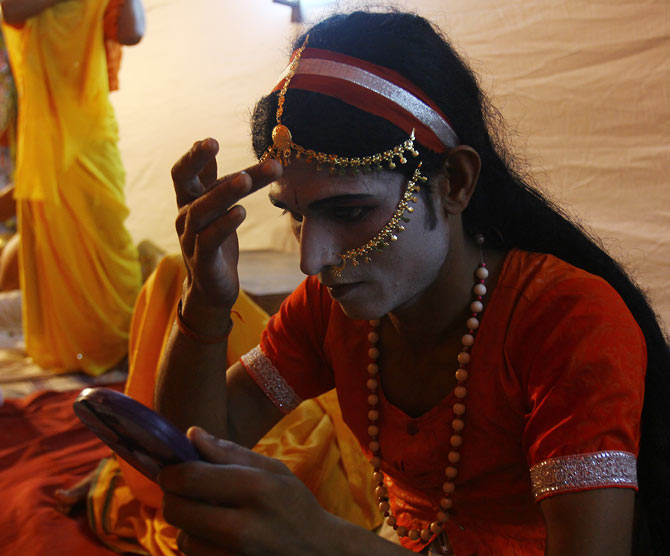
"Papa toh Mummy ban gaye (My father has become my mother)," giggles Bishnu Jha, the youngest member of the troupe.
Most of the 30-odd members don't know their exact age; they guesstimate Bishu's age at four or five years.
Little Bishnu is a bundle of mischief and perfectly suited for the role he will play later in the evening.
For a few minutes, he will be on stage as Hanuman, when the Ram bhakt shrinks to a tiny size in Lanka.
Since his make-up will only happen later, Bishnu has nothing better to do than roll a bolster around.
"Tumhe gira doonga (I'll trip you)," he warns with a naughty smile.
"Aap," corrects his careful father, Baiju.
"Aap toh Mummy ban gaye," says Bishnu again with a straight face, before he bursts into gales of laughter.
...
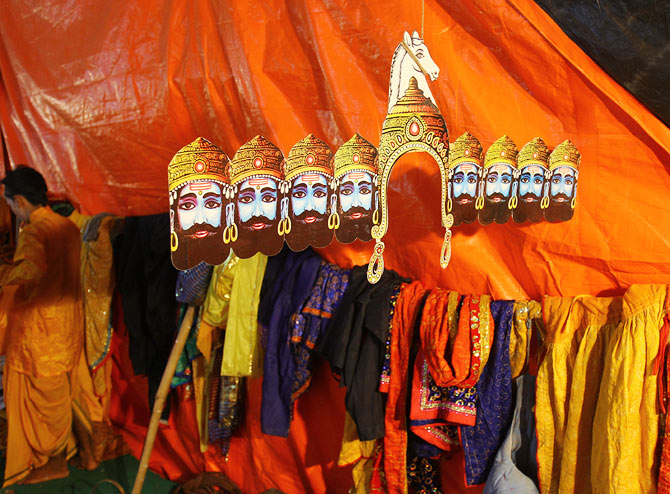
Tonight's show is about the Sita Haran and Hanuman's appearance in Lanka.
"We are the only Ram Leela Mandal that does not burn the effigy of Raavan," says Ranjit Singh.
"Raavan was not an ordinary man. He was a Brahman, he was a learned man. He has died once, he does not deserve to die again and again. We do not want this paap (sin) on our head," he says.
"He was an Adibhakt," says Pandit Shiv Kumar Jha, a senior member of the troupe. "Very stubborn."
"He had asked for a boon that no one except man or monkey could cause him harm," says 75-year-old Bhawani Shankar Das. "He realised that he needed to be released from his arrogant body so that he could worship the the lord again. He knew he had to sacrifice himself to Lord Ram.”
"Many famous actors have participated in our Ram Leela," says Singh. "The great Prithviraj Kapoor played Raavan on our stage."
...
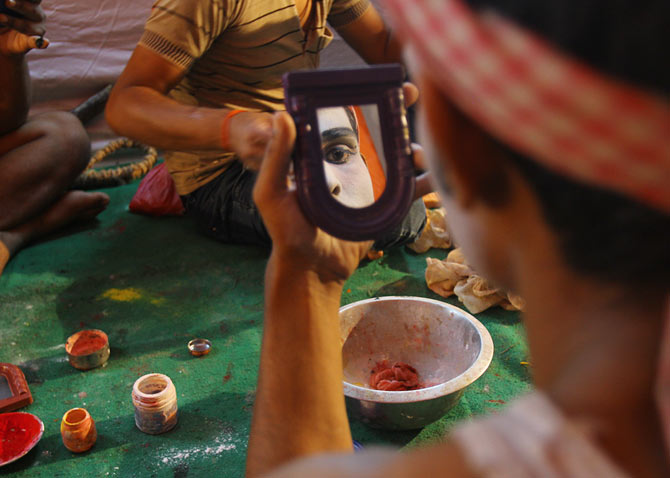
The only resemblance this rectangular enclosure has to a green room is a green carpet on the floor.
The artistes sit cross-legged on the floor, sharing bowls filled with powder and tumeric to transform themselves into gods.
Using their fingers, they rub a bright red colour -- one of the artistes calls it laali -- onto their lips to make them stand out in their whitened faces.
Eyebrows are defined -- into thick arches or delicate lines, depending on whether they are playing male or female characters -- and eyes are outlined with khol.
Rough sponge squares are used to dab in the powder; leftover agarbatti sticks to line the khol.
A series of steps leads downstairs to what should have been plain ground, but was now filled with muddy water that lapped mid-calf when you stepped into it.
...
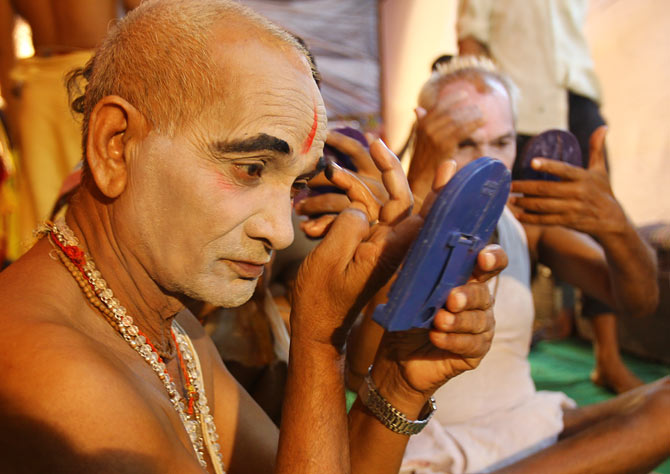
"We are the oldest Ram Leela Mandal in Mumbai," says Ranjit Singh.
The first Ram Leela was staged near Mumbai's General Post Office, where the Icchapurti Ganesh is now displayed every Ganeshostav.
"As our Ram Leela became more and more popular, we could not accommodate the crowd," he says. "So we moved here in 1961."
Over the years, the Mandal has split five times, for various reasons, but this, the Shree Maharashtra Ram Leela Mandal, say the organisers, is the original from which the others were born.
...
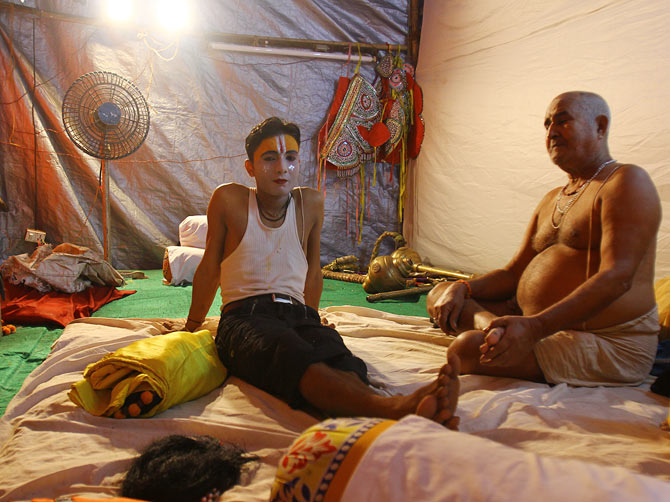
Unlike most other Ram Leelas, this one will go on for 20 days.
"We don't end on Dusshera," says Ranjit Singh. "Our Ram Leela goes on for 10 more days."
The troupe, which travels all the way from Aydhoya, stays in a nearby wadi.
Every evening, they come to Azad Maidan, to present the next episode of the Ram Leela.
It is hard work, says Singh, but gives spiritual satisfaction. Which is why they do not like their effort being trivialised.
On rare occasion, it does happen.
"Actor Shakti Kapoor came for one of our performances recently. When we invited him to speak on the stage, he made fun of saints, saying they were fake and gave the example of Asaram Bapu," says Singh.
"Our troupe members were very, very, angry at the way he spoke," he adds.
"What does he know about saints?" asks Bhawani Shankar Das. "Go to Ayodhya, go to other parts of India, you will see the real sant aatmas (saints) there."
"Someone like Asaram is a self-styled saint," says Pandit Shiv Kumar Sharma. "Look at where his karma has taken him -- to jail from where he will never get out."
"We asked Shakti Kapoor why he was tarring everyone with the same brush. One bad apple does not make the entire community bad. Then we asked Shakti Kapoor, if everyone was the same, why was he not as popular as Amitabh Bachchan? Why did he he not get the same kind of respect," laughs Das. "The man did not know where to look."
...
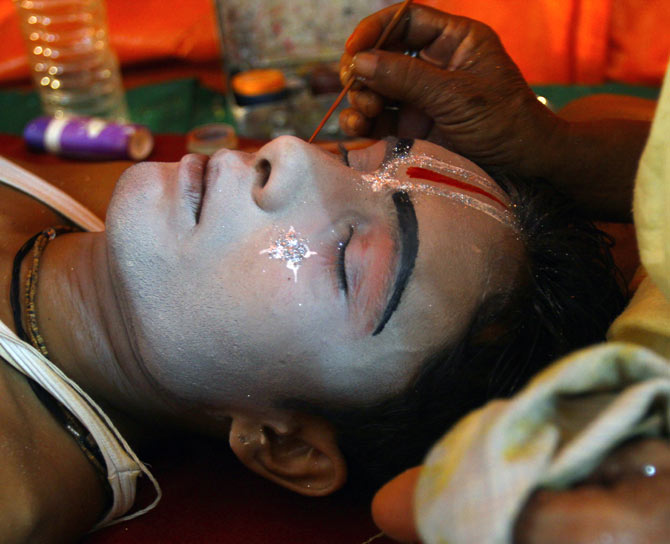
Most of the actors will put on their own make-up but the lead players -- Ram, Lakshman, Sita and Hanuman -- get a helping hand from their guru, Shashikant Das.
He carefully applies glitter on the actors, who lie down on the floor with their eyes closed.
...
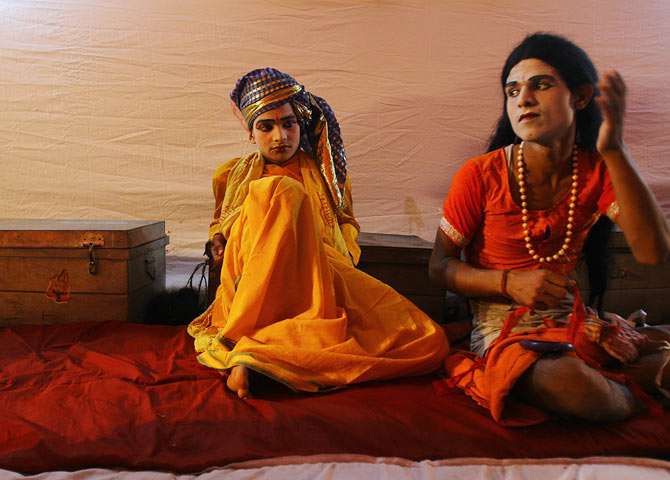
None of the younger members of the troupe go to school.
Instead, they are taught to read and write by the senior members of the troupe, with their learning focused on the Ramayana.
Vijay Kumar Bajpayee, who is around 15 to 16 years old, and his younger brother Ajay, who is around 11, have been touring with the Avadh Adarsh Ram Leela Mandal for a few years now.
They come from a family of 11 members, says Vijay. "Our parents didn't want us to go, but this is what we really wanted to do."
Even when they are not performing, the Mandal stays together.
"We do go home for short visits when we are in Ayodhya," says Vijay. "But this is our home now."
...
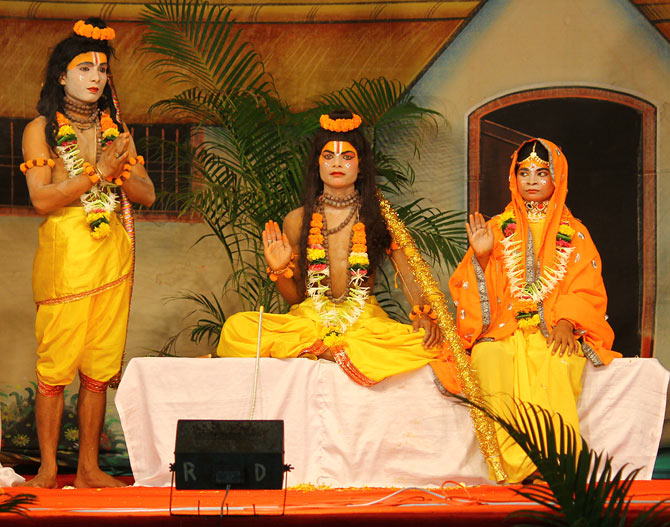
Staging a Ram Leela performance is not cheap, says Ranjit Singh.
"We need about Rs 20 lakhs (Rs 2 million) today, which about Rs 4.5 lakh (Rs 450,000) goes to the performing troupe," he says. "Not that I blame them. This is their only source of income and they have to feed around 30, 40 people every day and look after their other expenses. And then, Brahmans only eat food prepared in ghee (clarified butter); oil on't do. That makes their food even more expensive."
Then there is the stage and the seating area to be erected; the security set-up to be put in place; the loudspeakers and the electricity to be organised; the video screens to be put up; the permissions to be organised.
...
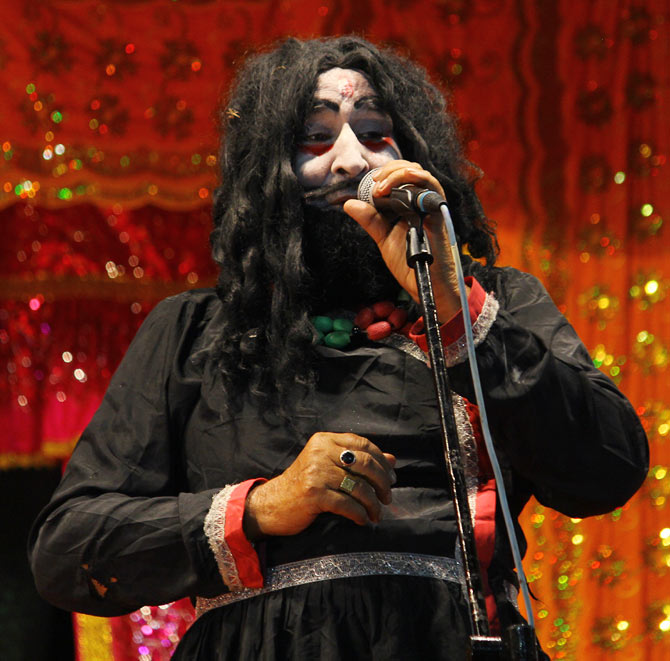
"The effort we put in does not matter," says Ranjit Singh. "We do this out of a sense of devotion."
The Ram Leela is a free performance, the audience is not charged a paisa.
"We collect the funds through donations," says Singh. "And if we fall short, we dip into our own pockets."
...
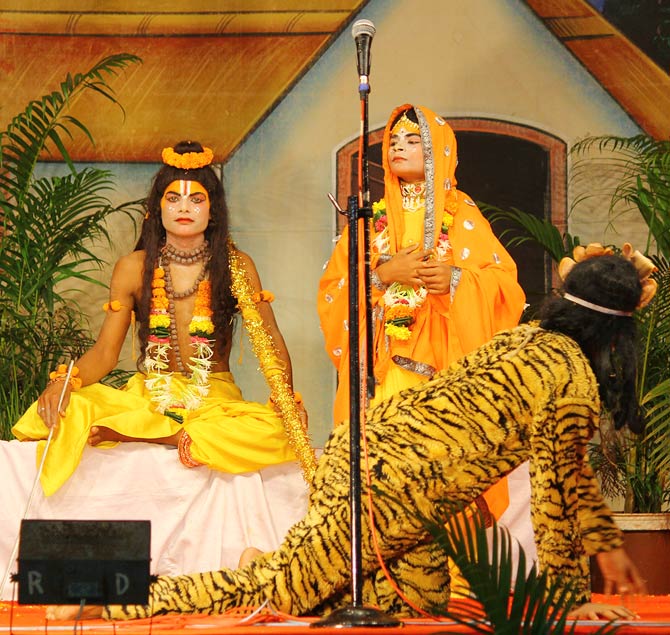
Each character is played by multiple actors.
If Mareech is played by one actor, then Mareech as the golden deer is played by another.
Raavan as the demon king is played by one actor; Raavan as the sadhu who begs alms from Sita is played by another.
Except for the main cast, the other actors play multiple roles as the supporting cast.
And, as they grow older and more infirm, they let younger actors take centrestage. For example, Bhawani Shankar Das, who used to play Hanuman, now plays Mareech.
...
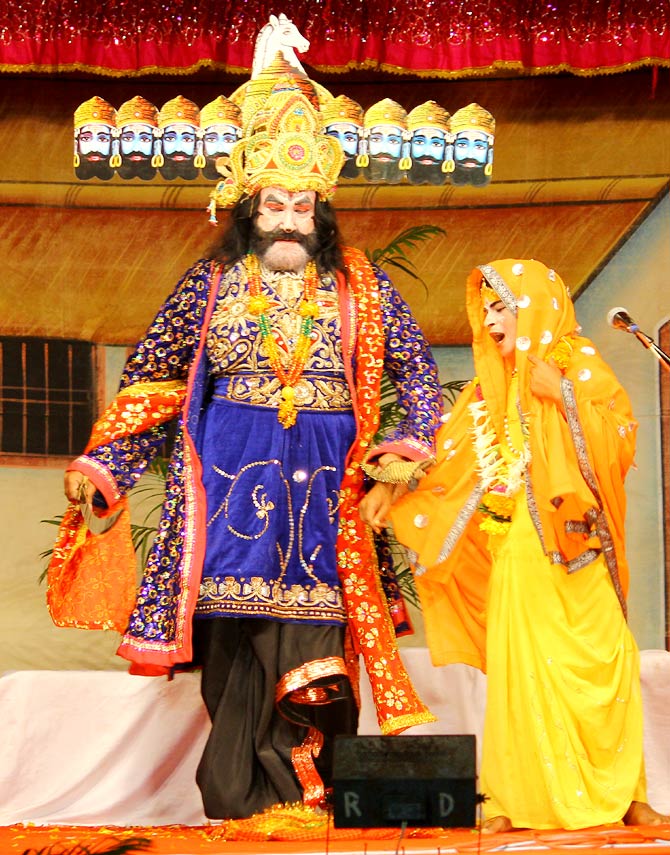
"Before 1953," says Bhawani Shankar Das, "the female roles would be played by women.
"Not any more.
"We are a sadhu mandal and ladies don't work on our stage. All the roles are played by men."
The men don't pad their chests to look feminine; they simply rely on make-up and costume.
"No bad words are allowed on our stage. No ghungroos (ankle bells) either."
...
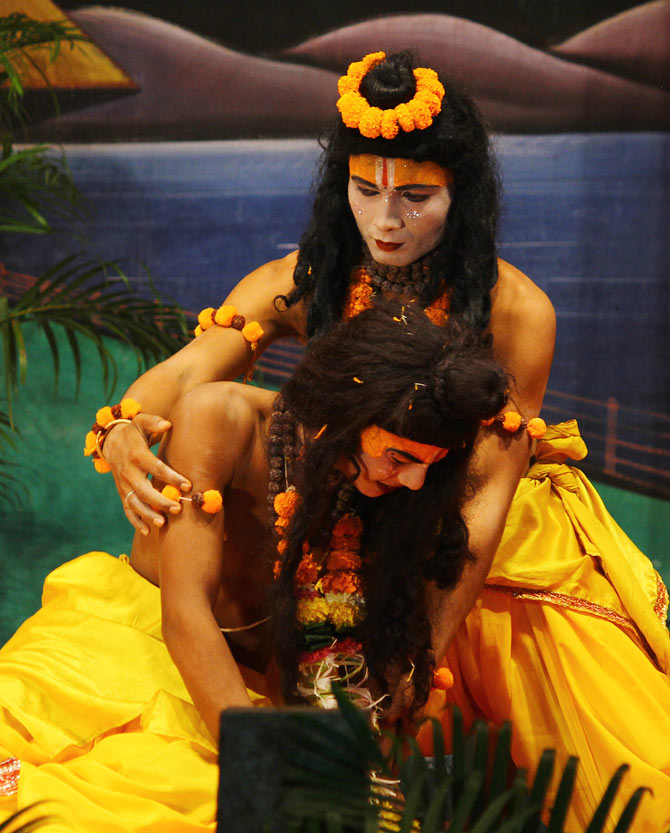
The curtain drops.
The audience knows what will happen next, but still waits with bated breath.
Then, the curtain rises again.
Ram and Lakshman, who realise they have been outwitted by the clever Mareech, rush back to their hut, but Sita has already been kidnapped by the arrogant Raavan.
...
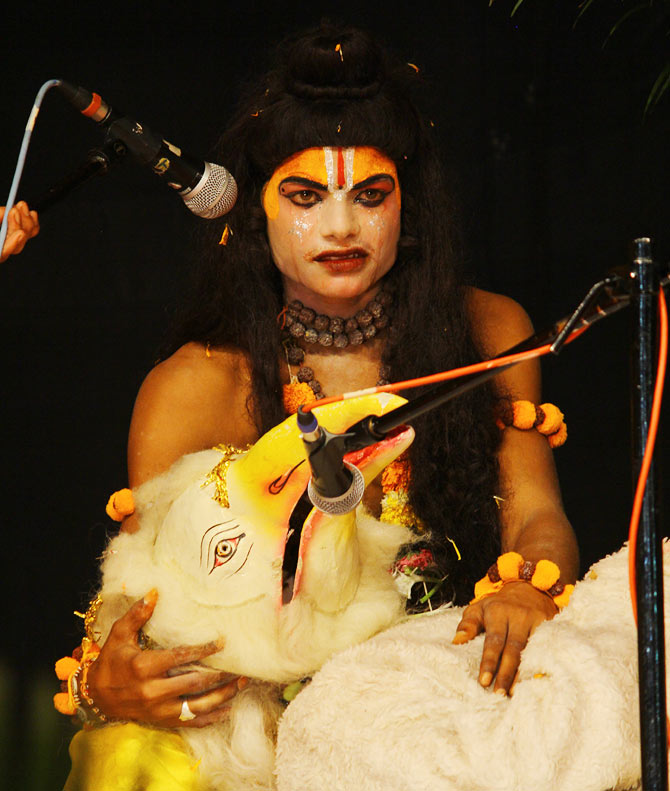
It is a solemn moment.
Lord Ram, in his search for Sita, discovers the dying Jatayu, who had valiantly attempted to rescue Sita.
In the battle that followed, Raavan grievously wounds the king of birds, who finally attains Moksha (salvation) at the hands of Lord Ram.
...
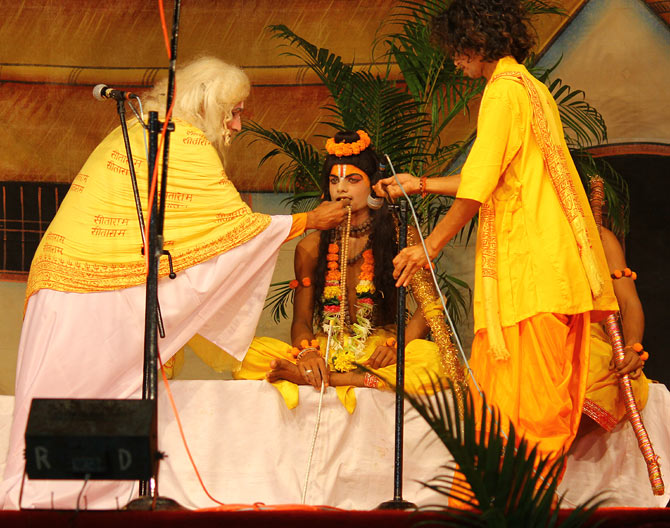
With just three microphones on stage, a lot of manipulation is required.
So each time the actors move, or the plot changes, other actors or helpers would walk on stage to adjust the angle or position of the mikes.
In some cases, like this one, the mike needed to be held in position.
None of these little niggles detracted from what was unfolding on the stage. The audience watched with rapt attention.
...
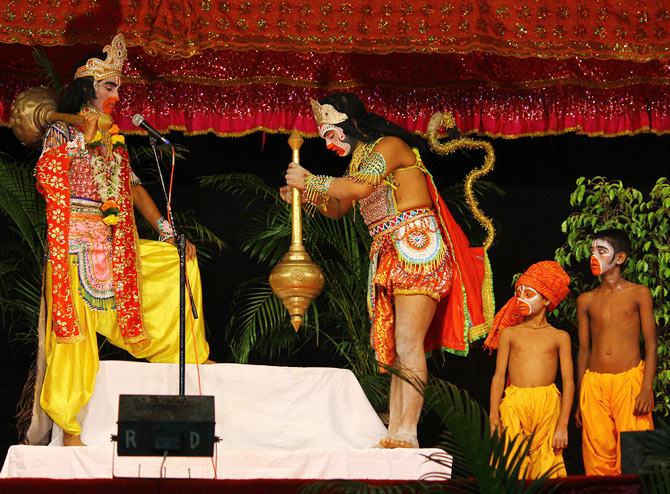
The hands of the clock turned, the minutes and hours slipped by.
But the audience was unaware.
They did not realise they were seated on a historic ground -- the ground where, in December 1931, Mahatma Gandhi addressed his largest political meeting ever.
The ground that has always welcomed protestors.
The ground, carved with 22 cricket pitches, that has served as a training schools for many Indian cricketers.
The ground where a certain Master Blaster, who announced his retirement on October 10, gave notice of his incredible talent with a record-breaking 664 run partnership with Vinod Kambli in a Harris Shield match.
Instead, they were caught up the magic that was being woven on the stage.
They joined in the bhajans; they laughed at the carefully placed humorous lines meant to evoke a smile.
All the chairs were now occupied; the looming clouds, as the organisers feared, hadn't deterred the devout.
On stage, Hanuman stepped down to discover who the two strangers were; little realising he was going to come face to face with the object of his devotion, Lord Ram.